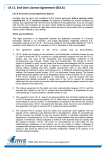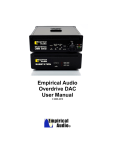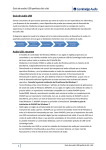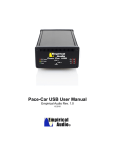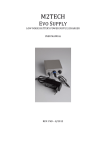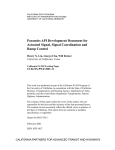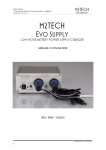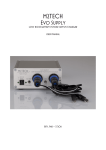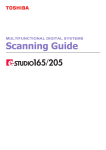Download Off-Ramp 5 User Manual rev 2.0
Transcript
Off-Ramp 5 User Manual Empirical Audio Rev. 2.0 © 2012 Off-Ramp 4 User Manual Empirical Audio Rev. 1.0 1. Function/Technology The Off-Ramp 5 is a versatile hi-res compatible USB interface. The function of the OffRamp 5 is to convert USB signaling into S/PDIF, AES and I2S so that a DAC can be driven with a computer audio data stream. The Off-Ramp 5 reduces jitter in the digital data stream by re-clocking using local oscillators. The Off-Ramp 5 incorporates our best low-jitter technology and includes an array of technical advantages over other devices on the market, including: • • • • • • • • Async USB, so the master clock is in the Off-Ramp, not the computer Inputs are re-clocked and I2S, S/PDIF and AES outputs are re-clocked again for lowest jitter External DC power source, allowing battery power or other supplies Separate input and output circuit power regulation High-quality discrete voltage regulation with Hynes regulators Precision impedance-matched high slew-rate S/PDIF and AES/EBU outputs I2S output interfaces for lowest jitter Modular design to allow for clock, power and USB improvements and upgrades These technical advantages allow the Off-Ramp 5 to be a world-class digital source, leaving even the most expensive CD transports and USB converters in the dust. The sound of the Off-Ramp 5 is unlike any other digital source. The clarity and imaging is unsurpassed, allowing you to “see” into the soundstage more than ever before. Width and depth are improved significantly. It is a totally immersive experience, the way that music playback should be. More like vinyl, only better. 1.1. What is jitter? Jitter is the number one problem limiting the performance of digital audio. Jitter creates an unnatural, harsh and sibilant sound that is pervasive in digital audio. Jitter causes listening fatigue with both CD players and computer audio devices. It’s only in the last three years that the audio industry has become sensitive to jitter and started actively addressing this. The sound of jitter is like looking through a window with a film on it. When jitter is reduced, it is like cleaning the window and finally seeing the scenery outside with crystal clarity and vividness. Jitter is the inaccuracy in the timing of the digital data. It is not data errors, it is inaccuracies in the timing of the presentation of the data to the D/A converter. This is different than sending digital data to a printer for instance, or even a hard-disk. These data transfers are not “real-time”. Streaming audio data from a CD transport or a computer source is real-time because the D/A converter creates a real-time analog signal from the data each time a new data word is presented. If the timing of the presentation of each word is inaccurate, this causes frequency modulation distortion. There is nothing that can be done about the samples in the recording and the clock that was used to make those samples, but playback jitter can be minimized. This is the role of the Off-Ramp 5. The Off-Ramp 5 virtually eliminates the sibilance and harshness due to jitter, making your digital playback closer to analog. The Off-Ramp 5 is a truly unique and remarkable product. Once jitter is minimized, the clarity, image focus and dynamics are improved significantly. Even bass-tightness improves. Recordings of rain, thunderstorms, violins, cellos, bongos and timpani are finally lifelike. 1.2. Theory of Operation The primary function of the Off-Ramp 5 is to convert USB streaming audio format into S/ PDIF, AES/EBU or I2S formats and provide hardware interfaces in order to be compatible with DACs. The Off-Ramp 5 is a re-clocker, meaning that the timing of the data flow into the device is retimed using internal clocks. This has nothing to do with the timing or tempo of the music. Because it utilizes an asynchronous USB interface, the master or system clock for your audio system is located in the Off-Ramp 5. This clock provides the timing for the dataflow from the computer source. This is the optimum way to achieve low jitter. The Off-Ramp 5 reclocker inserts between your computer or USB source and your DAC. The data stream is not modified or upsampled in any way, it only passes through. The only cable that is critical to performance is the cable between the Off-Ramp 5 and your DAC. This should be a high-quality S/PDIF coax, AES/EBU or I2S cable to minimize jitter. The USB cable can also be improved for even better sound quality, however the Belkin Gold supplied is quite good. 1.3. Performance of different outputs The four outputs all deliver world-class performance, however in highly resolving systems some differences may be audible. The I2S outputs deliver the lowest jitter, for those that have DACs with these types of inputs. Next best in performance is the S/PDIF or “coax” output. Finally the AES/EBU output is last because it requires an additional buffer to achieve the higher AES voltage spec. In most systems the differences are minor however and may not be audible. For non-Empirical Audio DACs with no I2S input, we recommend using the S/PDIF output with a high-quality 1.5m length S/PDIF coax cable. 1.4. Internal clocks and clock quality The Off-Ramp 5 comes standard with two clocks or free-running oscillators. Two clocks are required because the asynchronous USB interface uses free-running clocks rather than clocks that are synthesized from a single oscillator frequency. One clock is required for the sample-rate group 44.1/88.2/176.4kHz and a second for the 48/96/192kHz group because the two sample-rate groups are not related. These clocks can be upgraded, improving the jitter. The Turboclock is our latest dualclock upgrade, taking the Off-Ramp 5 to a new level that is unchallenged by other products in the marketplace. The Turboclock improves primarily bass tightness and impact, giving the bass more focus and body. These clock upgrades are not userinstallable. 2. Front-Panel: 2.1.1. Power LED Green indicator indicates DC power is applied to the DC input on back-panel. 2.1.2. Data Error Yellow indicator indicates that data stream is corrupted or not PCM. 2.1.3. USB Mute Red indicator indicates that USB signal is not being outputted. Generally occurs when a track is stopped or paused. Mutes the HDMI I2S output for PW DAC. 2.1.4. Sample-Rate LEDs One LED Illuminates to indicate the sample-rate of the incoming datastream. Only illuminates when the USB Mute LED is off. . 3. Back-Panel 3.1. 12VDC Input This is the power input for the Off-Ramp 5. The power from this input goes directly to the voltage regulators, and any installed clock upgrades, so the quality of this power is critical. Upgrades here make an immediate difference in jitter. Average power consumption is up to 500ma, depending on clock options, but much higher transient currents are possible. The connector is center positive, 2.5mm and protected from reverse voltage. To power-on the Off-Ramp 5, plug in the AC adapter and then connect the DC power cable to the Off-Ramp 5. 3.2. USB Input The USB input connects with a standard A-B USB cable to a computer or other streaming USB audio source. The streaming rate limit is 24-bits, 192kHz. The USB interface is asynchronous, so USB 2.0 compliant ports on the computer must be used. The USB cable can be as long as 5 meters or 16 feet. To prevent application and system crashes, it is best to close the music player application, such as iTunes, Amarra or Foobar BEFORE disconnecting the USB cable. Make sure that you load the USB driver into the computer before connecting the USB cable for the first time. It is recommended that you close your player application (such as Amarra, Pure Music, Foobar etc.), before you unplug the USB cable from the Off-Ramp 4 or computer. Then restart the application after the USB cable is reconnected. 3.3. S/PDIF Coax Output The S/PDIF coax output (optionally AES/EBU output) is the primary output that will connect to most DACs. The output impedance is 75 ohms. The cable that connects from this connector to your DAC should preferably be of highest quality and match the 75 ohm impedance. The S/PDIF output is transformer-coupled and isolated from earth ground. The cable attached to this connector should be at least 1.0m in length, but minimize the length beyond that. 1.5m is usually perfect and will work best with other gear. The internal cable in the Off-Ramp 4 also has 75ohm characteristic impedance. 3.4. AES/EBU Output The AES/EBU output is on a gold-plated XLR connector. Pin-out is standard pin1-Gnd, pin2 plus or non-inverted signal, pin3 minus or inverted signal. The output impedance between plus and minus conductors is 110 ohms. The output is transformer-coupled. The cable attached to this connector should be at least 1.0m in length, but minimize the length beyond that. 1.5m is recommended and will work best with other gear. 3.5. I2S RJ-45 output connector (single-ended signalling) I2S is a more direct D/A interface than S/PDIF. It was developed by Philips when Philips and Sony created the CD format and the S/PDIF interface specification. I2S is a three or four-signal interface that includes clocks. All four signals are provided at 3.3V logic levels at the Off-Ramp 5 output. I2S is the native interface for most D/A chips. Therefore if one can drive I2S directly and avoid S/PDIF translation, there is the opportunity to reduce jitter even more. Empirical Audio standard I2S interface uses 4 signals and 4 returns and the RJ-45 connector. It is compatible with I2S on several other manufacturers DACs, including Stello, Perpetual Technologies and Northstar, as well as our own Overdrive DAC. Other manufacturers DACs require an adapter cable to make the connection since they don’t all use RJ-45 and the pinouts are not compatible. A 1.5m cable length is recommended.. Make sure the I2S connectors are mated at both ends of the cable before powering-on either the Off-Ramp 5 or the DAC. Likewise, power both down before disconnecting the I2S cable. For operation without I2S cable, make sure that the supplied terminator is plugged into the I2S output jack. 3.6. I2S HDMI output connector (differential signaling) I2S compatible with Wired for Sound DAC2, PS Audio Perfect Wave DAC and others. Uses the HDMI connector, but is not compatible with HDMI signalling used for Home Theater, DVD, Blu-ray and Television. A standard HDMI cable can be used, however audiophile quality cables will perform better. 1.5m minimum cable length is recommended. Make sure the I2S connectors are mated at both ends of the cable before powering-on either the Off-Ramp 5 or the DAC. Likewise, power both down before disconnecting the I2S cable. 4. Software Software drivers must be loaded to support the USB interface for both PC and Mac before connecting the USB cable. For operation on a PC, Kernel Streaming is recommended to bypass Kmixer on XP machines and WASAPI on Vista and Win7 machines. 4.1. USB Drivers Drivers are located on the included CDROM disk. Load the appropriate driver for your machine and OS and execute it on the computer before powering the Off-Ramp 4 or connecting the USB cable to the computer for the first time. 4.2. Player Software For PC, the latest version of Foobar2000 is recommended as a player. Install this first. For XP, a Kernel Streaming plug-in is included on the CDROM. Copy this plug-in to the “components” folder under C:\Program Files\Foobar2000. Then start Foobar2000 and select the File pull-down. Then select Preferences. In the Preferences window, go to Playback – Output – select HiFace Kernel Streaming or Empirical Audio async 192. With XP, the sample-rate will be selected automatically. With Vista and Win7, you must change the sample-rate manually on the computer in control-panel/sounds and audio devices/advanced. For Mac, we recommend iTunes with software add-ons such as Amarra or Pure Vinyl to improve audio quality and eliminated manual intervention to select sample-rates. If you use iTunes alone, then select HiFace in Preferences/Audio and use Utilities/Midi options to select the sample-rate. Using iTunes alone requires you to manually select the sample-rate each time you change to playback of a different sample-rate. 5. Quick Start-up 5.1. Mac • Put the supplied CDROM into your Mac and find the Mac driver folder. • Open the folder and copy the driver software to your Mac hard disk. • Execute the driver installation and follow the instructions. • Power-on the Off-Ramp and connect the USB cable to the Mac and S/PDIF digital coax cable to the DAC. • Power on the DAC. • Check in the Perferences/Sounds that you have HiFace or Empirical Audio async 192 selected for output • Start your music player application • Check that both the red and yellow LEDs are off on the Off-Ramp • Play a track or playlist using your player application 5.2. PC • • • • • • • • • • • Put the supplied CDROM into your PC and find the PC driver folder. Open the folder and copy the correct driver software to your PC hard disk. Execute the driver installation and follow the instructions. Power-on the Off-Ramp and connect the USB cable to a USB 2.0 port on your PC and S/PDIF digital coax cable to the DAC. Power on the DAC. Check in the Control Panel/Sounds and audio devices that you have HiFace or Empirical Audio async 192 selected for output Install Kernel Streaming in your player application Start your music player application Select Empirical Audio 192 async Kernel Streaming for output Check that the yellow LED is off on the Off-Ramp Play a track or playlist using your player application • The red LED should be off when playing music 6. Specifications Inputs 1. USB – async 24/192 max sample-rate Outputs 1. S/PDIF coax 2. AES/EBU 3. I2S on RJ-45, Empirical Audio standard (3.3V) 4. I2S on HDMI, PS Audio standard (LVDS) Jitter specs (cycle to cycle, standard clock): S/PDIF coax output - <390psec total P-P jitter at all frequencies I2S Clock outputs - <250psec total P-P jitter at all frequencies 7. Compatibility The Off-Ramp 5 is designed to work with all DACs and SS receivers/processors. It works only in PCM mode. To operate with higher sample-rates, the DAC must support 24-bit operation as well as the higher sample-rate. USB 2.0 is required. Linux is not supported. Sample-rates supported: 44.1kHz, 48kHz, 88.2kHz, 96kHz, 176.4kHz, 192kHz Included 1. Off-Ramp 5 with 2 standard clocks (except with Turboclock upgrade) 2. BNC to RCA adapter plug 3. 12VDC AC adapter 4. 5m USB cable 5. CDROM with drivers and other software Options 1. Turboclock 2. S/PDIF Hynes voltage regulator 3. HDMI Hynes voltage regulator 4. RCA output connector rather than BNC 5. Revelation Audio Labs Cryo-Silver Reference I2S cable








